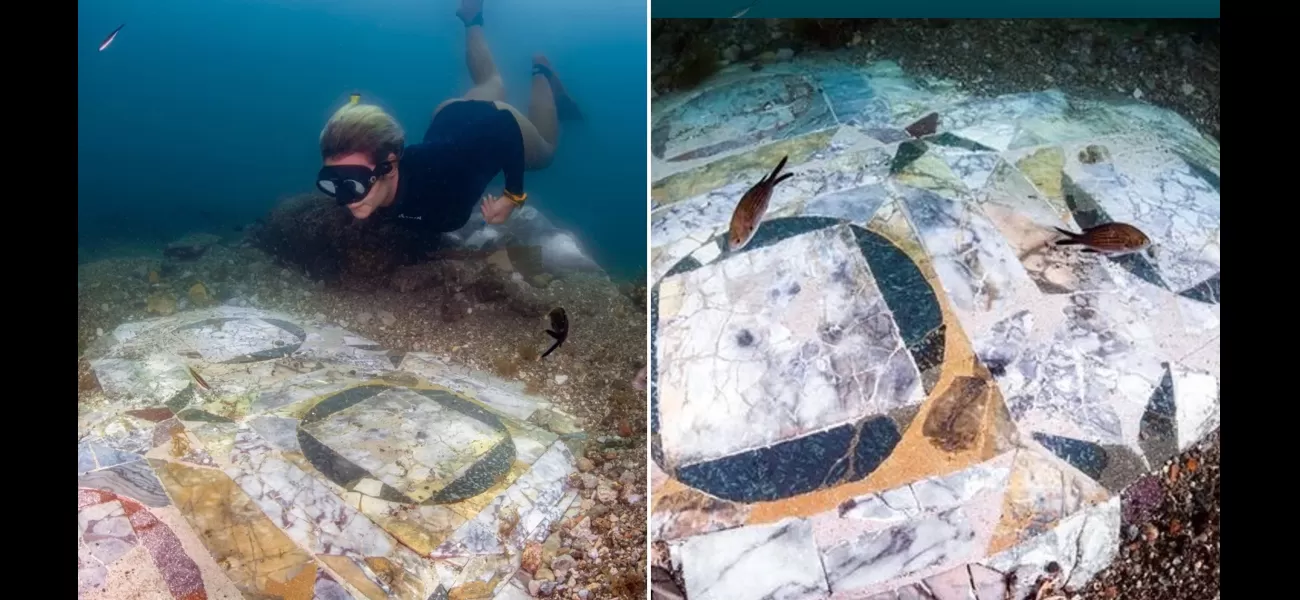Archaeologists find stunning marble floor in submerged city.
A large portion of the city is submerged.
July 27th 2024.

Deep beneath the surface of the sea, in the Gulf of Naples, Italy, lies the sunken city of Baiae. Once a luxurious vacation spot, it now rests among the ruins of a Roman city. Over the years, archaeologists have made many incredible discoveries in this underwater wonderland. And their latest find is truly breathtaking.
Recently, a team of underwater archaeologists stumbled upon a stunning marble floor in the sunken city. This discovery was shared on the Facebook page of the Archaeological Park of the Phlegraean Fields, and it has been causing quite a stir. The mosaic floor, made up of thousands of intricately placed marble slabs, is a masterpiece of design and craftsmanship. The team is currently working tirelessly to carefully recover and restore this incredible find.
According to reports from ILF Science, the floor is a colorful display of various shapes and shades, with elements of shell, mother-of-pearl, and glass intricately woven into the design. The post on the Facebook page explains that this mosaic is believed to have once graced the reception room of a luxurious villa during the third century. It was most likely owned by a wealthy and influential individual, given its opulent design and materials.
Baiae was once a bustling seaside resort, frequented by the elite of Rome, including famous figures such as Julius Caesar, Cicero, and Hadrian. The streets were lined with grand villas, and the main attraction was the rejuvenating hot springs, known for their healing properties. As time passed, Baiae also became known for its hedonistic offerings, earning it the nickname "The Las Vegas of Rome".
While some were drawn to the city for its pleasures, others, such as the famous philosopher Seneca, disapproved of Baiae's indulgent lifestyle. He famously declared that the place should be avoided due to its excessive vices and sins. The constant partying and drunkenness on the beaches disturbed his peaceful nature.
Sadly, Baiae's downfall began with the fall of the Roman Empire. The city was attacked by various invaders, and in the eighth century, it was seized by Muslim armies. Later, in the 16th century, volcanic activity in the Phlegraean Fields caused much of the city to sink below sea level. Over time, some of the city's treasures, including statues, were looted or removed by archaeologists and displayed in museums, such as the Archaeological Museum of Campi Flegrei.
In 2002, the underwater site was declared a Marine Protected Area, and although licensed divers are allowed to explore, they must do so with a local guide. Today, the main concern is not looters, but the natural wear and tear caused by the sea, its tides, marine life, and human activity. But with each new discovery, the underwater city of Baiae continues to captivate and amaze, offering a glimpse into the grandeur and decadence of ancient Rome.
Recently, a team of underwater archaeologists stumbled upon a stunning marble floor in the sunken city. This discovery was shared on the Facebook page of the Archaeological Park of the Phlegraean Fields, and it has been causing quite a stir. The mosaic floor, made up of thousands of intricately placed marble slabs, is a masterpiece of design and craftsmanship. The team is currently working tirelessly to carefully recover and restore this incredible find.
According to reports from ILF Science, the floor is a colorful display of various shapes and shades, with elements of shell, mother-of-pearl, and glass intricately woven into the design. The post on the Facebook page explains that this mosaic is believed to have once graced the reception room of a luxurious villa during the third century. It was most likely owned by a wealthy and influential individual, given its opulent design and materials.
Baiae was once a bustling seaside resort, frequented by the elite of Rome, including famous figures such as Julius Caesar, Cicero, and Hadrian. The streets were lined with grand villas, and the main attraction was the rejuvenating hot springs, known for their healing properties. As time passed, Baiae also became known for its hedonistic offerings, earning it the nickname "The Las Vegas of Rome".
While some were drawn to the city for its pleasures, others, such as the famous philosopher Seneca, disapproved of Baiae's indulgent lifestyle. He famously declared that the place should be avoided due to its excessive vices and sins. The constant partying and drunkenness on the beaches disturbed his peaceful nature.
Sadly, Baiae's downfall began with the fall of the Roman Empire. The city was attacked by various invaders, and in the eighth century, it was seized by Muslim armies. Later, in the 16th century, volcanic activity in the Phlegraean Fields caused much of the city to sink below sea level. Over time, some of the city's treasures, including statues, were looted or removed by archaeologists and displayed in museums, such as the Archaeological Museum of Campi Flegrei.
In 2002, the underwater site was declared a Marine Protected Area, and although licensed divers are allowed to explore, they must do so with a local guide. Today, the main concern is not looters, but the natural wear and tear caused by the sea, its tides, marine life, and human activity. But with each new discovery, the underwater city of Baiae continues to captivate and amaze, offering a glimpse into the grandeur and decadence of ancient Rome.
[This article has been trending online recently and has been generated with AI. Your feed is customized.]
[Generative AI is experimental.]
0
0
Submit Comment





